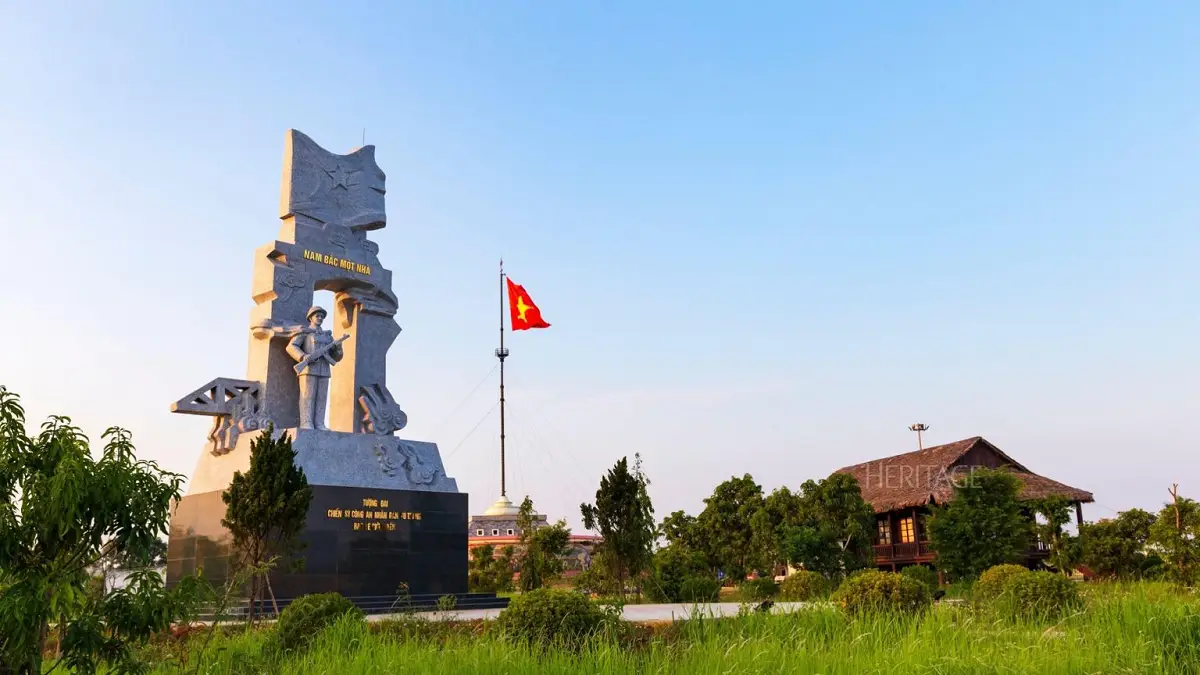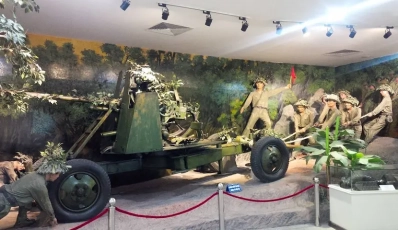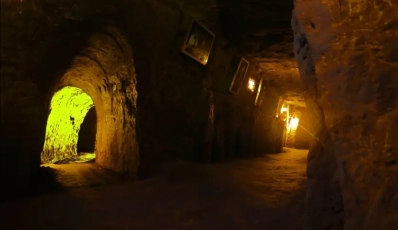When traveling to Quang Tri, visitors should not forget the Hien Luong Bridge - one of Quang Tri’s most famous tourist attractions. As the bridge is located right next to National Highway 1A, it is convenient for tourists who want to visit this historic place on their journey to discover Central Vietnam.
1. Introduction to Hien Luong Bridge
When first built in 1928, Hien Luong Bridge was made of wood, supported by iron poles 2 meters wide. It was mainly used to serve pedestrians crossing the Ben Hai River. In 1952, the French rebuilt a new bridge with 7 spans, 178 m long, 4 m wide, reinforced concrete piers and pine wood deck, 1.2 m high railings on both sides and a maximum load of 18 tons.

Under the Geneva Agreement, a demilitarized zone of the 17th parallel, from the mouth of the Ben Hai River to the Vietnam-Laos border, became a temporary military demarcation zone dividing Vietnam into two regions: the North and the South.
At that time, the Hien Luong bridge crossing the Ben Hai River was also divided into 2 parts belonging to 2 regions and painted in 2 colors: the southern part of the bridge (on the south bank) painted yellow, the northern part of the bridge (on the north bank) painted blue, the border between the two parts of the bridge was a 1 cm wide horizontal white line.

The bridge was destroyed by American bombs in 1967. Then, it became a "symbol" of the separation of the nation as much as the Vietnamese people's desire for reunification.
To preserve the historical records of the Hien Luong Bridge, Quang Tri Province restored the Hien Luong Bridge based on its design in 1952. Notably, the railing of the bridge is also painted in 2 colors blue-yellow to represent the Hien Luong bridge during the period when the country was still divided.
2. Things to see in the relic complex of Hien Luong Bridge - Ben Hai River
2.1. Police station
According to the provisions of the Geneva Agreement, there would be four police stations along the banks of the Ben Hai River (the demarcation line river). Therefore, on the north bank of the river were the Hien Luong and Cua Tung police stations, and on the south bank of the river were the 2 police stations of Xuan Hoa and Cat Son.

The police stations had about 20 personnel, equipped with pistols and machine guns teamed up with the responsibility of controlling the status of the demilitarized zone, the number of passersby, and mutual control in the enforcement of the demilitarized zone. The agreement was placed under the supervision of International Organization 76 (including representatives from Canada, India, and Poland).
In 1967, two stations on the southern shore were destroyed by American bombs. So far, only 2 stations on the northern bank of the river remain, they were also later restored by Quang Tri Province according to the previous prototype.
2.2. Hien Luong Flagpole
The current flagpole is a model simulating the flagpoles built earlier by the government and army of the Democratic Republic of Vietnam. The flagpole is 28 meters high and consists of 6 pieces of steel pipe connected. On the top, there is a flag with a five-pointed yellow star.

The flagpole also has a system of cables, pulleys, and winches to facilitate flag-raising. The lower part of the flagpole is round, and decorated with images depicting the history of the revolution.
2.3. Architectural complex on the southern bank of the Ben Hai River.
To simulate the former demilitarized zone of the 17th parallel and to build a historical destination for tourists, Quang Tri Province established the "The 17th Parallel and the Desire for Unification" exhibition house and monument complex on the southern bank of the Ben Hai River.
The exhibition hall consists of 2 rooms. A statue of President Ho Chi Minh is located in the ceremony space. The booth displays 53 documents and artifacts directly related to the struggle of the Vietnamese army and people on the Hien Luong Bridge-Ben Hai River during the war of resistance against the United States. Also featured is a restored version of a 500W loudspeaker previously used by the Government and Army of the Democratic Republic of Vietnam on the northern bank.

The monumental complex "The Desire for Unification" was built on an area of 2,700 m², consisting of two parts. The base is assembled from numerous stone blocks of different sizes. The monument part is made of green stone: the front part consists of 2 statues of a mother (7.70 m high) and a child (5.50 m high).
The stones were created to simulate the Southerners' look with sorrow at the North when they could not cross the river to meet their husbands, fathers, and relatives during the years of separation.
2.4 The Piers of Ben Hai River
The Ben Hai River originates from Dong Chan Mountain in the Truong Son Range, flows through a land of nearly 100 km long, along the 17th parallel from west to east, and flows into the Cua Tung Estuary.

Ben Hai River has some famous piers including Cua Tung (Pier A), Tung Luat (Pier B), Luy (Pier C), Thuong Dong, and Duc Duc. The Cua Tung and Tung Luat piers are two piers that played a significant role in the Vietnamese people's victory. Cua Tung pier (Pier A) belongs to the Cua Tung beach area (Cua Tung City). This is the anchorage of ships and boats that carried soldiers from 1954 to 1975. Currently, this pier is located in an area of 187.6 m2, surrounded by a system of fences.
Tung Luat Pier (Pier B) was formerly about 150 m long, belonging to Tung Luat village, Vinh Giang commune (now Cua Tung town), 7 km east of Hien Luong Bridge and 2 km from Cua Tung Sea to the west. This is one of the secret anchorages used to transport soldiers, citizens, weapons, and ammunition to the southern shore. It is also one of the main starting points of the sea route.
3. Historical significance of the relic of the Hien Luong Bridge-Ben Hai River
After the wars, the relics on both sides of Hien Luong became a special historical relic complex. The Hien Luong Bridge-Ben Hai River relic complex, including the Hien Luong Bridge, the flagpole on the north bank, the Union House, the police station, the monument complex "The Desire for Reunification," the exhibition house "The 17th Parallel and the Desire for Unification" on the south bank, has become war witnesses from which we can tell and educate the young generations of Vietnam and the world about a bloody war period so that they can understand the price of peace and independence.
The Hien Luong Bridge itself, in fact, also has many stories to tell.
4. Stories about battles without gunfire on the Hien Luong Bridge
4.1. The Battle for the Flag
Under the provisions of the Geneva Agreement, each side would have 2 police stations: the Hien Luong Cua Tung station on the northern shore, and the Xuan Hoa and Cat Son stations on the southern shore. Among the battles that took place in Hien Luong, perhaps "the battle for the flag" was the fiercest. It lasted 14 years.
Since the demarcation line was drawn, each side will try to raise its flag higher than that of the enemy. Whenever the red flag with the yellow star was hoisted high, people on both sides of the North and South cheered happily. The United States was completely surprised by this event; they hastily elevated their flag poles to 35 meters. In return, in 1962, the Vietnamese government sent a flagpole to Hien Luong. The flagpole was 38.6 meters high and the flag was 134 m2 wide, weighing 15kg. There was also a cabin 10 meters from the top of the flagpole where Vietnamese soldiers could pick up and hang the flag. It is the highest flagpole in the area.

On August 2, 1967, the Hien Luong Bridge was collapsed by bombs and the flagpole also broke. That same night, they focused on rebuilding another flagpole with an electric pole attached to a mast.
The flagpole was broken many times, but each time it was brought down by bombs, the army and the people of the North Shore rebuilt and raised it as soon as possible. Many of the Vietnamese soldiers sacrificed bravely to protect the flag as the heart of our nation, some stories have become legends of the Hien Luong Bridge.
4.2. Battle of painting colors
The Hien Luong Bridge is not only famous for the battle of flagpoles but also for the battle of paints. The boundary line dividing South - North Vietnam on the bridge is a line painted in white with only 1 cm wide.

To create the image of a separation of our country, the U.S.-Saigon government actively painted the color blue on the southern part of the bridge. But with the intention of unification, as soon as it finished painting at the beginning of the day, in the night the northern soldiers painted the remaining half of the bridge blue to merge it into one color.
Later, when the southern part of the bridge was painted brown, the northern part then changed the color. As a result, the Hien Luong Bridge could change color on a daily basis. Whenever the United States painted a different color, the North Vietnamese soldiers immediately painted the same color.
4.3. Battle of the sounds
On the banks of the Hien Luong Bridge, there was also a battle of the sounds or the battles of speakers. After the Geneva Agreement, to encourage people to fight for national reunification, the North Vietnamese government built a loudspeaker system, distributed in 5 groups along a length of 1,500 meters on the north bank. Each group of 24 25 W speakers was facing the south bank.
Every day, their speaker system broadcasted the Voice of Vietnam programs, musical programs, recitations, plays, and folk songs.

Annoyed by this, a few weeks later, the South Vietnamese government brought the loudspeaker sets produced by West Germany and Australia to the southern shore. This was when the fight started. Every day the speakers were on from early afternoon to one or two in the morning, at full volume. In early 1960, a high-capacity American speaker system was brought to the southern shore. The government of the Republic of Vietnam believed that with this system, their words could reach as far as Quang Binh.
Not giving up, the North Vietnamese government added a loudspeaker system comprising a speaker with a diameter of 1.7 m and 4 speakers of the 250 W type. The speaker arrays are placed on solid concrete pillars and the 500 W speaker was placed on a mobile vehicle. In 1965, when the United States bombed the North, the speaker systems on both sides stopped working.
The Hien Luong - Ben Hai Banks Relic has become an attractive and meaningful tourist attraction, contributing to educating patriotic traditions, and enhancing national pride and awareness of the independent sovereignty, unification, and territorial integrity of Vietnam not only for today but also for future generations.
See our package to Quang Tri:
>> The Central Heritage sites | Classic package tour from Quang Binh - 06 Days
>> From Quang Binh to Hue & Hoi An | Classic package holiday - 07 Days
>> Phong Nha - Hue - Hoi An | Adventure package tour - 08 Days





















 TRAVELERS' CHOICE 2025
TRAVELERS' CHOICE 2025 


